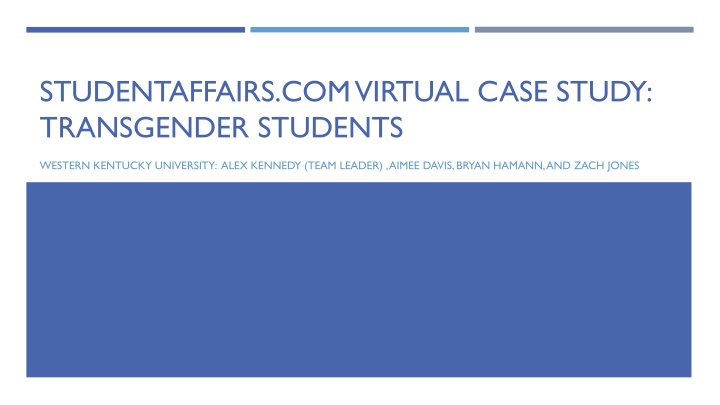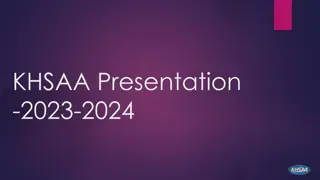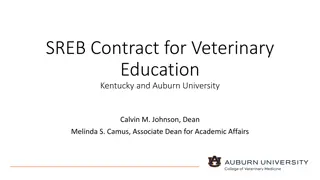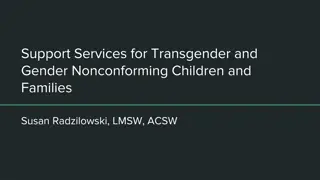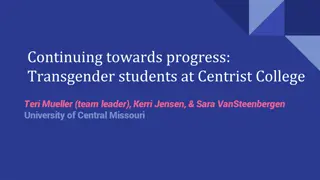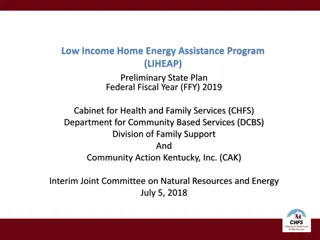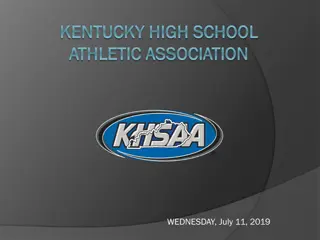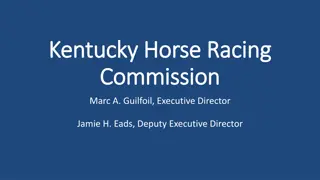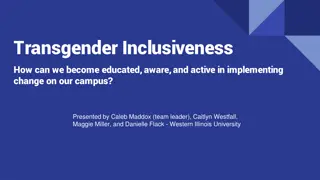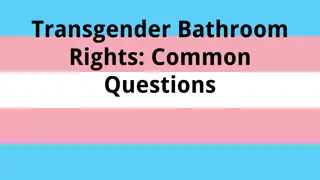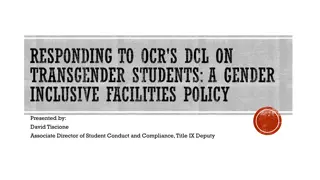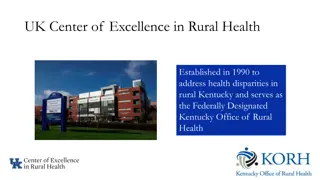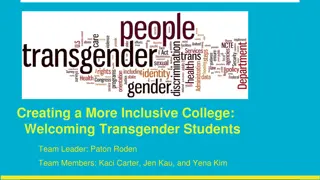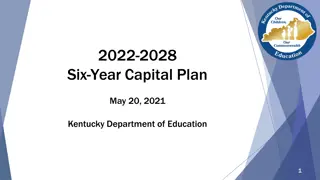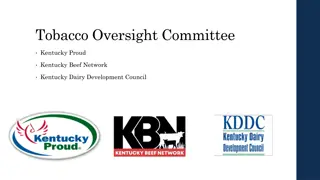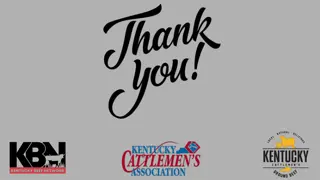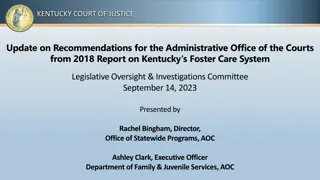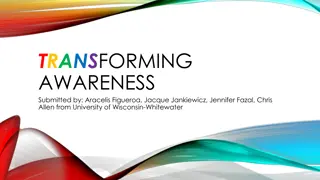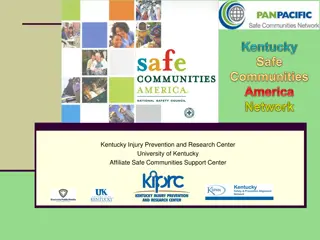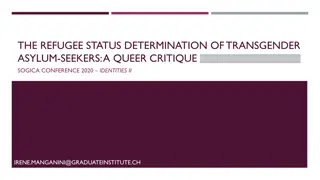Transgender Students at Western Kentucky University
Centrist College, a mid-sized institution, is exploring campus initiatives to support transgender students. Learn about transgender facts, institutional background, and action plans in this case study.
Download Presentation

Please find below an Image/Link to download the presentation.
The content on the website is provided AS IS for your information and personal use only. It may not be sold, licensed, or shared on other websites without obtaining consent from the author.If you encounter any issues during the download, it is possible that the publisher has removed the file from their server.
You are allowed to download the files provided on this website for personal or commercial use, subject to the condition that they are used lawfully. All files are the property of their respective owners.
The content on the website is provided AS IS for your information and personal use only. It may not be sold, licensed, or shared on other websites without obtaining consent from the author.
E N D
Presentation Transcript
STUDENTAFFAIRS.COM VIRTUAL CASE STUDY: TRANSGENDER STUDENTS WESTERN KENTUCKY UNIVERSITY: ALEX KENNEDY (TEAM LEADER) , AIMEE DAVIS, BRYAN HAMANN, AND ZACH JONES
OUTLINE Institutional Background Transgender Community Facts CAS Standards Current Campus Initiatives Campus Specific Definitions Action Plan Cost Analysis Quotes Sources
INSTITUTIONAL BACKGROUND Centrist College is a mid-sized institution In recent years, it has been a growing institution that currently enrolls 17,000 undergraduates and 2,000 graduates. It is a teaching university that focuses on the education of students while also producing important research. Campus Breakdown Statistics: 74% white 13% black 3% Hispanic Most students are full time traditional students (under 25) with 77% living on campus and 75% from the state There are 16 residence halls on campus: 6 Co-ed (suite style) 6 Female only (community style) 4 Male only (community style) *Centrist College uses the acronym LGBT for all matters related to the LGBTQIA* community
TRANSGENDER INFORMATION Transgender is a term that describes a person whose gender identity differs from the sex marked on their birth certificate. Just as attempting to change a person s sexual orientation does not work, neither does changing a person s gender identity. Trans people seek to bring into better alignment their gender identity and gender expression. Transgender is an ADJECTIVE and not a NOUN. The correct way of using the term would be Suzie is a transgender person. Sexual orientation is not the same as gender identity. Sexual orientation is related to who someone is attracted to/fall in love with while gender identity is about self identity. As a sign of respect, we should always refer to a transgender person by their desired pronoun. If you are not sure which to use you could say something like, Hi, my name is Jeff and I prefer he or his pronouns. How about you? We should not refer to them by their birth name if they do not express that it is okay. The trans flag has five stripes. The outer two are light blue and the inner two are light pink, representing the traditional colors for baby boys and baby girls, while the middle stripe is white to represent those who are intersex, transitioning, or consider themselves having a neutral or undefined gender. (it was designed to) be horizontally symmetrical so that no matter which way you fly it, it is always correct, signifying us finding correctness in our lives. (thinkprogress.org)
TRANSGENDER FACTS Injustice at Every Turn a report by the National Center for Transgender Equality and the Task Force reported: Trans people are four times more likely to live in poverty 90% of trans people have experienced harassment, discrimination, or mistreatment on the job Trans people cannot serve in the US Military Most states do not offer legal protection for trans individuals in the areas of housing, employment, and health care 41% of the survey respondents reported attempting suicide as opposed to 1.6% of the general population While discrimination was found throughout all respondents it was made worse when combined with racism. People of color in general fared worse than white participants. 46% of respondents reported feeling uncomfortable going to the police for assistance
TRANSGENDER FACTS, CONTINUED While there are many barriers that trans individuals face, there is an overwhelming amount of determination and resiliency. My mother disowned me. I was fired from my job after 18 years of loyal employment. I was forced onto public assistance to survive. But still I have pressed forward, started a new career, and rebuilt my immediate family. You are defined not by falling, but how well you rise after falling. I m a licensed practical nurse now and am studying to become an RN. I have walked these streets and been harassed nearly every day, but I will not change. I am back out there the next day with my head up. Injustice at Every Turn: A Report of the National Transgender Discrimination Survey, Executive Summary respondent
CAS STANDARDS An LGBT professional (and center) should promote issues regarding the overall campus climate and general support for LGBT students on the campus. This can be accomplished by advocating for a campus climate free from harassment and violence; training students and staff members what a supportive environment for everyone would be, identifying and publishing allies, identify negative conditions (policies, departments, etc.) and propose solutions, creation and maintenance within the institution s policies which promote a healthy climate. It is important that designated LGBT services and offices are not the only divisions and offices meeting the needs of LGBT students and advocating for them
RELEVANT CAS STANDARDS Programming: Integrate into the life of the institution Reflective of demographic and developmental profiles of the represented student population Utilize multiple formats, strategies, and contexts for delivering a message Services should provide the following: Coming out support with particular attention to multiple identities especially race, ethnicity, disability, religion, family of origin issues, and internalized homophobia and biphobia Services for victims, survivors, and perpetrators of homophobia, biphobia, and transphobia Services to address family issues Services for addressing dating issues for those who date only people of the same sex, who may date individuals of either sex, or someone who is transgender or dates someone transgender Services to address domestic and relationship violence Services to address body image concern Health Services: Health forms with inclusive language HIV/STD testing services with intake and follow-up protocols appropriate for LGBT people Sex-specific services for those whose sex and gender may not align (e.g. pap smears for female bodied individuals who identify as males) Inclusion of transgender specific healthcare coverage by any insurance offered by the institution
RELEVANT CAS STANDARDS, CONTINUED Career Services: Information on LGBT friendly employers Employer mentoring programs for LGBT students Information on LGBT issues in the workplace, coming out and transitioning on the job Public Safety: Training for police officers to respond appropriately when an LGBT student is involved in an incident Avoidance of re-victimization of LGBT students who have experienced bias Admission and Registration: An easily navigable process for documenting and maintaining records of changes in names or sex, and supports individuals who are in the process of transitioning with the use of a preferred name Housing: Housing assignments which respect students gender when it conflicts with their legal sex The availability of married student housing for same sex couples Facility policies (restroom and locker room included) which accommodate and support individuals who are transitioning or whose appearance may not fit a traditional male/female division Student Activities: Recreational and intramural sports, and other recreational opportunities which include and support individuals who do not fit into traditional sex segregated categories Access to opportunities for membership in student activities including fraternity and sorority life
CAS STANDARDS On any campus, particular attention should be given to financial aid, athletic scholarships, fraternity and sorority life, employment opportunities, and campus engagement/co- curricular activities on campus.
CURRENT CAMPUS INITIATIVES Inner Group Dialogue program Identity-specific student organizations Safe Zone Trainings Gender-neutral bathrooms temporary locations Gender and Communication Conference Lavender Graduation Social Justice University Committee LGBT Meet and Greet with University President
CAMPUS SPECIFIC DEFINITIONS OIDI: Office of Institutional Diversity and Inclusion: Provide resources to campus community and external community Promote inclusive excellence, access, and social justice for all SIO: Student Identity Outreach: Provide resources in the form of information, connections, and events for Centrist College s gender, sexual minority, and queer population Educate all students, staff, and faculty on gender and sexual minorities history and issues Advocate for the interests of gender and sexual minorities CDO: Chief Diversity Officer: Responsible for guiding efforts to conceptualize, define, assess, nurture, and cultivate diversity as an institutional and educational resource
IMPORTANCE OF EDUCATIONAL CAMPUS PROGRAMMING Educating the campus community meant tearing down those barriers and privileged belief systems that presented major obstacles to understanding. To raise awareness, students and faculty delivered educational presentations to different groups just about what it means to be a member of the transgender community and provided packets of information to counter common myths and stereotypes (Case et al., p 11) A large part of making an environment more inclusive is to change the vocabulary and actions of the people in the environment. Actions and vocabulary do not change without education being provided. Adopting transgender inclusive language in nondiscrimination statements for colleges and universities should not be mistaken to be a brief process. The work of facilitating a cultural shift, the reality of what often must occur, is time consuming and one that requires partnership across traditional lines of power and privilege. The co-intentional educational process that results from tackling such change through student activism promotes learning both in and outside of the classroom (Case et. al., p 16). This process cannot come from one group or one person. It has to be a campus wide effort where every department is putting forth the same message. Cooperation, communication, and collaboration are key.
ACTION PLAN OUTCOME 1: RAISE AWARENESS AND EDUCATE ALL STUDENTS, FACULTY, AND STAFF ON THE LGBT COMMUNITY Establish a task force to create measures to determine the current perceptions of inclusivity on campus: This task force will be called upon to create a campus-wide survey for all stakeholders regarding the climate and perceptions of the LGBT community on campus We need to seek to provide areas both online and offline where all students, faculty, and staff can attest to their perceptions and opinions regarding the inclusive atmosphere of campus. This will further help us determine the reality of turning our campus into one more inclusive of transgender students. This will be established within the first month of implementing the plan in order to gain immediate knowledge and attention. This task force will be responsible for the timely implementation of all action items Multiple constituents from across campus will work together to implement this. While a Social Justice Committee already exists on the campus, this task force would be responsible for the specific LGBT population on campus Establish an educational series through the Office of Institutional Diversity and Inclusion on the LGBT community: This educational series will include a three week long session with a one hour session once a week in which each department on campus is required to send a representative who can then relay the information back to the entire department at a later date. Through a series of guest speakers (including students), videos, and a clear direction of next steps for our campus, awareness will be raised regarding facts, statistics, and improvement of the university. This educational series will be completed within the next six months and departments will then have 2 months to relay their information appropriately. The Office of Institutional Diversity and Inclusions will be in charge of organizing and executing this series. Educate multiple professionals on campus who can conduct a Safe Zone training session: This Safe Zone training session will be required for faculty and staff to complete in order to further raise awareness and educate individuals on our campus of how to interact with students who are LGBT. These Safe Zone Trainings would also educate participants on discriminatory language, pronouns, and microaggressions. Safe Zone Training needs to be completed by all individuals within the first eight months of implementing this action plan. With 3,455 employees at the university, there is currently only one individual trained in Safe Zone facilitation at Centrist College. 1. 2. 3.
ACTION PLAN OUTCOME 2: DEVELOP ADDITIONAL AREAS OF SUPPORT TO IMPROVE EQUITY AMONG STUDENTS, FACULTY, AND STAFF Implement support groups within the Office of Institutional Diversity and Inclusion for transgender students: 1. Multiple (3) support groups will be established specifically for students who identify within the LGBT community. These support groups will include one for the LGBT community, a discussion group for the LGBT community, and lastly a support group specifically for gender identity (transgender) students. These three support groups will be established within the first year of this plan being implemented. The Office of Institutional Diversity and Inclusion will work with groups such as the Student Identity Outreach to ensure this is implemented. Establish a specific training for academic advisors in which they are educated on how to support transgender students: 2. This training is necessary for students are required to meet with an advisor on campus. Advisors are further available to listen and provide resources when necessary for students. Due to this, advisors need to be educated on questions to ask transgender students, developing an understanding for their background and immediate needs, meeting transgender students where they are, and having knowledge of all campus and community resources available to them. This training for advisors will be completed within the first year. It will be more in depth in comparison to the three week series mentioned in outcome one. This is due to the time advisors might spend with their students over other departments on campus. The Office of Institutional Diversity and Inclusion as well as the Student Identity Outreach program will work to ensure the success of this training. Establish an additional counselor within the Counseling and Testing Center: 3. This counselor would be certified in identity topics such as sexuality and gender. This counselor will report to Chief Diversity Officer and make recommendations on creating and maintaining a more inclusive and healthy climate. This position should be created with an effective hire and start date within one full academic year of implementing this plan.
ACTION PLAN OUTCOME 3: DEVELOP COLLABORATION AMONG CAMPUS DEPARTMENTS TO CREATE A MORE INCLUSIVE CAMPUS ENVIRONMENT Establish communication with multiple campus resources regarding current LGBT policies and laws both on campus and off campus: 1. In order to help campus further understand where our students may run into issues within the outside community, we need to be sure to discuss these issues within certain offices and ensure these students do not run into such issues within our campus community. This includes ensuring our health care policies incorporate coverage of transgender students, ensuring admissions procedures and the ID center allow students to identify as they choose as well as providing such options for students, and adding and altering campus restrooms to be inclusive of both sex. While there are gender-neutral bathrooms on campus presently, their location and ease of access must be improved. The current options are an acceptable temporary solution but not sustainable for a growing campus. There should be an institutional effort to employ universal design for all restrooms in order to include all students. Within a year and a half all constituents will be aware of such issues and be actively working towards changing any policies or procedures they need to in an attempt to become more inclusive for transgender students. The Office of Institutional Diversity and Inclusion as well as Facilities Management will work closely together to implement these policies and procedures. Work closely with Housing and Residence Life to implement concrete procedures and additional living arrangements for LGBT students: 2. Review current procedures within Housing and Residence Life and raise the discussion of implementing safe spaces within the residence halls or even an LGBT living learning community area of the residence hall open for all students who wish to be included in such an inclusive and supporting environment. Establish and implement a Social Justice wing within a current residence hall. This wing would provide housing for non-gender conforming, LGBT, and ally students as well as other areas of Social Justice. This wing would be modeled after the Social Justice Wing at University of Arizona (www.lgbtq.arizona.edu/campus-housing-options) New policies and procedures will be implemented within one year of start date. A collaboration among The Office of Institutional Diversity and Inclusion, Housing and Residence Life, and Facilities Management would implement these living arrangements and procedures.
ACTION PLAN OUTCOME 4: DEVELOP INITIATIVES AND RESOURCES FOR LGBT STUDENTS REGARDING EMPLOYMENT AND PROFESSIONAL DEVELOPMENT 1. Establish resources within the Career and Professional Development Center specifically for the LGBT community: Educate students regarding employment law Implementation of an LGBT Job Fair where potential employees and students can connect in a safe space Organizing and connecting LGBT students with Career Counselors and mentors This resource should be completed within one year. The Career and Professional Development Center and Office of Institutional Diversity and Inclusion would collaborate on these efforts. 2. Implementation of a non-discriminatory compliance statement: To be signed by all employees affiliated with the institution (included but not limited to full-time, part-time, auxiliary, and student workers). This compliance statement should be effective for the upcoming fall semester (six months). This would be a collaboration between the Human Resources Department and Office of Institutional Diversity and Inclusion.
COST ANALYSIS: OUTCOME 1 Establishing a task force would not incur any additional costs --- this would be an ad hoc committee of various, educated professionals on campus. The establishment of an educational series through the Office of Institutional Diversity and Inclusion for and about the LGBT community could be part of the responsibility of various personnel in OIDI therefore not requiring any additional funding. Safe Zone is a completely free web-based resource so utilizing their resources will not require additional funding. Printing of the resources and the costs of using campus space would be minimal. We would encourage the Office of Institutional Diversity and Inclusion to use their meeting/training space within the office. We would suggest a printing budget of $500 for the school year. We would offer the opportunity to be trained to serve as a Safe Zone Facilitator to various faculty/staff/administration on campus. This would cost $4,500 for a Safe Zone national Train-the-Trainer visit. This would be a two-day, two-trainer visit. This price is all inclusive. With an institution the size of Centrist College, we would suggest having one Safe Zone facilitator for every 250 employees. With 3,455 employees, that would equate out to roughly 13 additional facilitators. These facilitators could and should be diverse and from various offices on campus. Potential areas could be faculty/staff from financial aid, athletic scholarship, fraternity and sorority life, student employment, and campus engagement/co-curriculars. These areas were specifically mentioned in the CAS Standards. These additional facilitators would help LGBT students see there is a culture of care throughout the campus.
COST ANALYSIS: OUTCOME 2 Implementation of 3 support groups would not have major cost associated with them. An annual budget of $100 per group could be allocated towards printed brochures, advertising, and meeting refreshments, but not necessary. Establish a specific training for various campus offices: A $2,000 salary increase for the individual currently conducting Safe Zone trainings would allow them to serve as the campus Lead Safe Zone Trainer, where they are responsible for the campus-wide Safe Zone Initiative. The salary increase would justify their added responsibility. They will also be responsible for the specialized trainings for different campus functional areas. Establish an additional counselor. Salary would be $43,000 with approximately $20,000 in additional benefits (health insurance, 401k, etc.) needing to be allocated toward the position s cost.
COST ANALYSIS: OUTCOME 3 There would be limited costs associated with communicating LGBT laws and policies to campus resources. However there will need to be a small fund to work with Facilities Management to implement gender-neutral bathrooms. We have allocated $15,000 to this initiative. The current gender-neutral bathrooms were a temporary fix that needs to be addressed. To create a Social Justice Wing within a residence hall on campus would be an affordable accommodation. We suggest utilizing a hall that is already arranged in a suite style as it is more cost effective. This will also allow us to monitor the potential loss of revenue if the interest is not as prevalent as anticipated. If interest is lower than anticipated, we could still utilize gender-neutral rooms as the bathrooms are included in the suite. The only major costs associated would be updating current forms and applications to show the new option for students and updating any common area s gender specific bathrooms. We have allocated $5,000 to updating these forms and bathrooms.
COST ANALYSIS: OUTCOME 4 The creation of an LGBT Job Fair would cost roughly $200 total. This would include room reservations and any PR and marketing material. Many costs would be covered through the registration fee of the various participating organizations or companies. The proposed non-discriminatory compliance statement would be created with the assistance of General Council resulting in no additional costs.
COMPLETE COST ANALYSIS Action Plan Outcome Establish a task force Cost $0.00 Educational Series through OIDI $0.00 Safe Zone Facilitator Train-the-Trainer trainings $4,500 (all inclusive) Support Groups $300 ($100 per group, 3 total groups) Campus Office Safe Zone trainings $2,000 Establishment of an additional counselor $63,000 ($40k salary and $23k benefits) Gender-Neutral bathrooms $15,000 Social Justice Wing $5,000 LGBT Job Fair $200 Non-Discriminatory Compliance Statement $0.00 TOTAL: $90,400
BIBLIOGRAPHY (n.d.). Campus housing options. Retrieved from www.lgbtq.arizona.edu/campus-housing-options (n.d.). Pearce ford tower (bowling green, ky). Retrieved from https://upload.wikimedia.org/wikipedia/commons/7/7f/Pearce_Ford_Tower_(Bowling_Green,_Kentuc ky).jpg (n.d.). Student affairs diversity action and assessment plan: Illinois state university. Retrieved from http://studentaffairs.illinoisstate.edu/downloads/diversity_action_plan.pdf (n.d.). University profile. Retrieved from studyqa.com/tpl/common/img/university_profile.png?25 (n.d.). Wku flags. Retrieved from http://media.graytvinc.com/images/wku-flags-1_107549071.jpg Case, K. A., Kanenberg, H., Erich, S., & Tittsworth, J. (2012). Transgender inclusion in university nondiscrimination statements: Challenging gender-conforming privilege through student activism. The Journal of Social Issues, 68(1), 145. doi: 10.1111/j.1540-4560.2011.01741.x Ford, Z. (2014, August 27). Transgender pride flag designer applauds smithsonian lgbt artifacts collection. Retrieved from http://thinkprogress.org/lgbt/2014/08/27/3476435/transgender-pride-flag/ Grant, J.M., Mottet, L. A., Tanis, J., Harrison, J., Herman, J. L., Keisling, M. (2011). Injustice at every turn: A report of the national transgender discrimination survey, executive summary. Retrieved from http://www.transequality.org/sites/default/files/docs/resources/NTDS_Exec_Summary.pdf Lindenberg, M. (2012).Transgender students: Seven recommendations for academic advisors. Retrieved from http://www.nacada.ksu.edu/Resources/Clearinghouse/View-Articles/Advising-issues- for-transgender-students.aspx Vidani, P. (n.d.). Transquotes. Retrieved from http://transquotes.tumblr.com/
